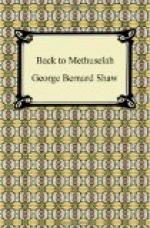All this, remember, is the state of things in the pre-Darwin period, which so many of us still think of as a pre-evolutionary period. Evolutionism was the rage before Queen Victoria came to the throne. To fix this chronology, let me repeat the story told by Weismann of the July revolution in Paris in 1830, when the French got rid of Charles the Tenth. Goethe was then still living; and a French friend of his called on him and found him wildly excited. ’What do you think of the great event?’ said Goethe. ’The volcano is in eruption; and all is in flames. There can no longer be discussion with closed doors.’ The Frenchman replied that no doubt it was a terrible business; but what could they expect with such a ministry and such a king? ‘Stuff!’ said Goethe: ’I am not thinking of these people at all, but of the open rupture in the French Academy between Cuvier and St Hilaire. It is of the utmost importance to science,’ The rupture Goethe meant was about Evolution, Cuvier contending that there were four species, and St Hilaire that there was only one.
From 1830, when Darwin was an apparently unpromising lad of twenty-one, until 1859, when he turned the world upside down by his Origin of Species, there was a slump in Evolutionism. The first generation of its enthusiasts was ageing and dying out; and their successors were being taught from the Book of Genesis, just as Edward VI was (and Edward VII too, for that matter). Nobody who knew the theory was adding anything to it. This slump not only heightened the impression of entire novelty when Darwin brought the subject to the front again: it probably prevented him from realizing how much had been done before, even by his own grandfather, to whom he was accused of being unjust. Besides, he was not really carrying on the family business. He was an entirely original worker; and he was on a new tack, as we shall see presently. And he would not in any case have thought much, as a practical naturalist, of the more or less mystical intellectual speculations of the Deists of 1790-1830. Scientific workers were very tired of Deism just then. They had given up the riddle of the Great First Cause as insoluble, and were calling themselves, accordingly, Agnostics. They had turned from the inscrutable question of Why things existed, to the spade work of discovering What was really occurring in the world and How it really occurred.
With all his attention bent in this new direction, Darwin soon noticed that a good deal was occurring in an entirely unmystical and even unmeaning way of which the older speculative Deist-Evolutionists had taken little or no account. Nowadays, when we are turning in weary disgust and disillusion from Neo-Darwinism and Mechanism to Vitalism and Creative Evolution, it is difficult to imagine how this new departure of Darwin’s could possibly have appealed to his contemporaries as exciting, agreeable, above all as hopeful. Let me therefore try to bring back something of the atmosphere of that time by describing a scene, very characteristic of its superstitions, in which I took what was then considered an unspeakably shocking part.




